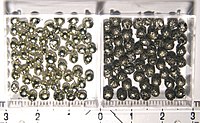
Photo from wikipedia
An attempt to reduce, replace, or even eliminate the synthetic resins from wood-based panels alongside broadening the array of raw lignocellulosics is still essential and attractive. Many pretreatments of lignocellulosics… Click to show full abstract
An attempt to reduce, replace, or even eliminate the synthetic resins from wood-based panels alongside broadening the array of raw lignocellulosics is still essential and attractive. Many pretreatments of lignocellulosics have been studied, among which steam explosion (SE) resulted in superior physical-mechanical properties of the obtained binder-less boards. However, the SE pretreatment leads to a relatively strong odor, which is even emitted from the obtained binder-less boards independent of the raw lignocellulosic, raising concern about the use of the boards. Emissions of volatile organic compounds (VOCs) were investigated in the framework of the study from binder-less boards obtained from different SE raw lignocellulosics and SE-untreated suberinic acids-bonded particleboard. VOCs were collected by headspace solid-phase microextraction (HS-SPME) and analyzed by gas chromatography–mass spectrometry (GC–MS) for 28 days with an interval of 2 weeks. The results showed that the number of detected VOCs and their chromatographic peak area varied significantly depending on the raw lignocellulosic, board density, and post-treatment (overlayering), decreasing over time. The lowest area of detected VOCs was demonstrated by the suberinic acids-bonded particleboard, while the highest area was detected from the high-density binder-less board obtained from SE hemp shives with the main compound of furfural (up to 70%) in all board types.
Journal Title: Materials
Year Published: 2022
Link to full text (if available)
Share on Social Media: Sign Up to like & get
recommendations!